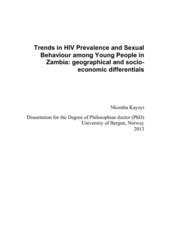| dc.contributor.author | Kayeyi, Nkomba | en_US |
| dc.date.accessioned | 2013-06-18T10:25:32Z | |
| dc.date.available | 2013-06-18T10:25:32Z | |
| dc.date.issued | 2013-05-07 | eng |
| dc.identifier.isbn | 978-82-308-2286-9 | en_US |
| dc.identifier.uri | https://hdl.handle.net/1956/6707 | |
| dc.description.abstract | Introduction: Differences in the distribution of HIV between and within SSA countries is striking. Recent evidence indicates that HIV prevalence of young people, which is used as a proxy of HIV incidence, has been declining. There is convincing evidence that much of this decline is attributable to changing sexual behaviour. However, HIV epidemiological research has previously focused only on individual factors affecting sexual behaviour and HIV transmission, but recent evidence shows that neighbourhood factors play a significant role. HIV prevalence in Zambia has been estimated at 14.3% among adults (15-49 years) and 6.6% among young people (15-24 years). The major factors believed to be driving the epidemic in Zambia have been extensively surveyed, e.g. early age at sexual debut, concurrent sexual partnerships, low condom use and age-mixing. As a result of the epidemic, multiple prevention programmes have been implemented that have targeted different risk groups and age-groups. Overall objective: To assess trends and examine factors influencing the differential geographical distribution of HIV prevalence and risky sexual behaviours among young people in Zambia. Methods: The empirical basis was from the national antenatal (ANC) sentinel surveillance system on HIV and syphilis, the Zambia Demographic and Health Survey (ZDHS), the Zambia Sexual Behaviour Survey (ZSBS), and a population-based HIV survey in selected urban and rural areas (Chelston and Kapiri Mposhi). A systematic review of peer-reviewed articles on HIV data from Zambia has also been included. Results: ANC-based surveillance showed that HIV prevalence among young women has substantially declined during the period 1994 to 2008 (by 43% in urban and 17% in rural settings). Peer-reviewed articles were also in agreement with these findings; however, both the ANC-based data and the ZDHS data showed striking geographical variation in HIV prevalence in Zambia. Regarding factors affecting HIV infection, young women residing in low educational attainment neighbourhoods in selected communities were at higher risk of HIV infection than those in high educational attainment neighbourhoods. With regard to sexual risk behaviour, there were substantially declining trends between 2000 and 2009 for premarital sex (in both young men and women) and multiple partnerships (only young men). Condom use at last premarital sex remained stable among young people during the same period. Factors associated with lower risk of premarital sex included urban residence, high residential stability, and high comprehensive knowledge of HIV. Conclusion: HIV prevalence among young pregnant women declined substantially during the 14-year period. Parallel decline probably occurred among men, but trend data are limited. The decline in HIV prevalence can probably be attributed to the change in sexual risk behaviour among young people. Both sexual risk taking and HIV prevalence are strongly associated with factors reflecting socio-economic status at both individual and neighbourhood levels. | en_US |
| dc.language.iso | eng | eng |
| dc.publisher | The University of Bergen | eng |
| dc.relation.haspart | Paper I: Nkomba Kayeyi, Knut Fylkesnes, Charles Michelo, Mpundu Makasa, Ingvild Sandøy. (2012) Decline in HIV prevalence among young women in Zambia: Nationallevel estimates of trends mask geographical socio-demographic differences. PLoS ONE 7(4): e33652, April 2012. The article is available at: <a href="http://hdl.handle.net/1956/6472" target="blank">http://hdl.handle.net/1956/6472</a> | en_US |
| dc.relation.haspart | Paper II: Nkomba Kayeyi, Ingvild F Sandøy, Knut Fylkesnes. Effects of neighbourhoodlevel educational attainment on HIV prevalence among young women in Zambia. BMC Public Health 9: 310, August 2009. The article is available at: <a href="http://hdl.handle.net/1956/6706" target="blank">http://hdl.handle.net/1956/6706</a> | en_US |
| dc.relation.haspart | Paper III: Nkomba Kayeyi, Knut Fylkesnes, Nora Wiium, Ingvild F. Sandøy. Decline in sexual risk behaviour among young people in Zambia (2000–2009): Do neighbourhood contextual effects play a role? Full text not available in BORA. | en_US |
| dc.title | Trends in HIV Prevalence and Sexual Behaviour among Young People in Zambia: geographical and socioeconomic differentials | en_US |
| dc.type | Doctoral thesis | |
| dc.rights.holder | Copyright the author. All rights reserved | |

